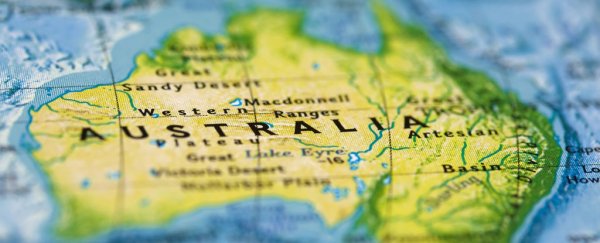Australia has had to change its position on world maps four times in the past 50 years.
The country happens to be located on one of the world's fastest-moving tectonic plates, travelling about 6.9 centimetres (2.7 inches) north per year. That's almost three times as fast as the plate on which the US is positioned, which only travels around 2.5 centimetres (1 inch) per year.
According to Dr Lucia Perez-Diaz from the Department of Earth Sciences at Royal Holloway University, tectonic plates – the massive chunks of earth on which continents sit – move about as fast as your fingernails grow; between 5 to 10 centimetres (2 to 4 inches) per year.
"The reason why different plates move at different speeds is relatively simple: each plate is different," Perez-Diaz told Business Insider. "For each plate, its rate of motion will be determined by a balance between the forces trying to make it move and those resisting that motion."
 More north than you thought. Credit: Reto Stöckl/NASA Goddard Space Flight Centre
More north than you thought. Credit: Reto Stöckl/NASA Goddard Space Flight Centre
The North American plate, Perez-Diaz said, moves relatively slowly because of how much resistance is imposed by the Pacific plate being pushed underneath it.
The Indio-Australian plate is the opposite, which is being shoved north by the Antarctic plate and pulled under the Eurasian and Pacific plates in the same direction.
"In this case, the forces acting at opposite sides of the Australian plate do so in the same direction, helping the plate travel faster," Perez-Diaz said.
A few centimetres sounds like a relatively small distance, but because of this shift, maps and models of our planet can become out of date. This isn't so much of a problem on a model globe, but it can cause problems for GPS and satnav systems.
A few inches of difference can mean longitudes and latitudes don't line up with GPS coordinates, and in 1994 the adjustment was a whole 200 metres, which is enough to get your deliveries to the wrong house.
The next adjustment is due at the end of the year and will be about 1.5 metres, which is not quite enough to throw off GPS this time.
However, the next generation of GPS devices that use satellites and ground stations will be accurate to within an inch, and this precise location is important for Australia's mining industry, which is set to use more and more autonomous trucks, which rely on coordinates.
For everyone else though, Perez-Diaz says this change is unlikely to cause havoc.
"GPS recalibration may become a routine task in some parts of the world, but one that, in my view, is unlikely to have a great impact in most people's everyday life," she said.
"Most of us won't live long enough or own the same GPS device for a long enough period to have to worry about adjusting it to account for how much the plate we are standing on has moved."
Nobody really agrees on why tectonic plates are moving around
Dr Perez-Diaz says the mechanisms behind plate motion are still very much a matter of debate.
"Tectonic plates are broken pieces of the Earth's rigid outer layer which – through time – 'glide' over the viscous upper part of the mantle," Perez-Diaz explained. "For a time, convection currents within the mantle were believed to be the sole drivers behind plate tectonics."
"However it is now recognised that mantle convection alone is unlikely to be powerful enough to drive the motion of large tectonic plates."
As for the other problems they cause – such as earthquakes, tsunamis, and volcanic events – these happen in specific areas along where plates meet, and the monitoring of them to predict when they will happen is improving all the time.
This article was originally published by Business Insider.
More from Business Insider:
